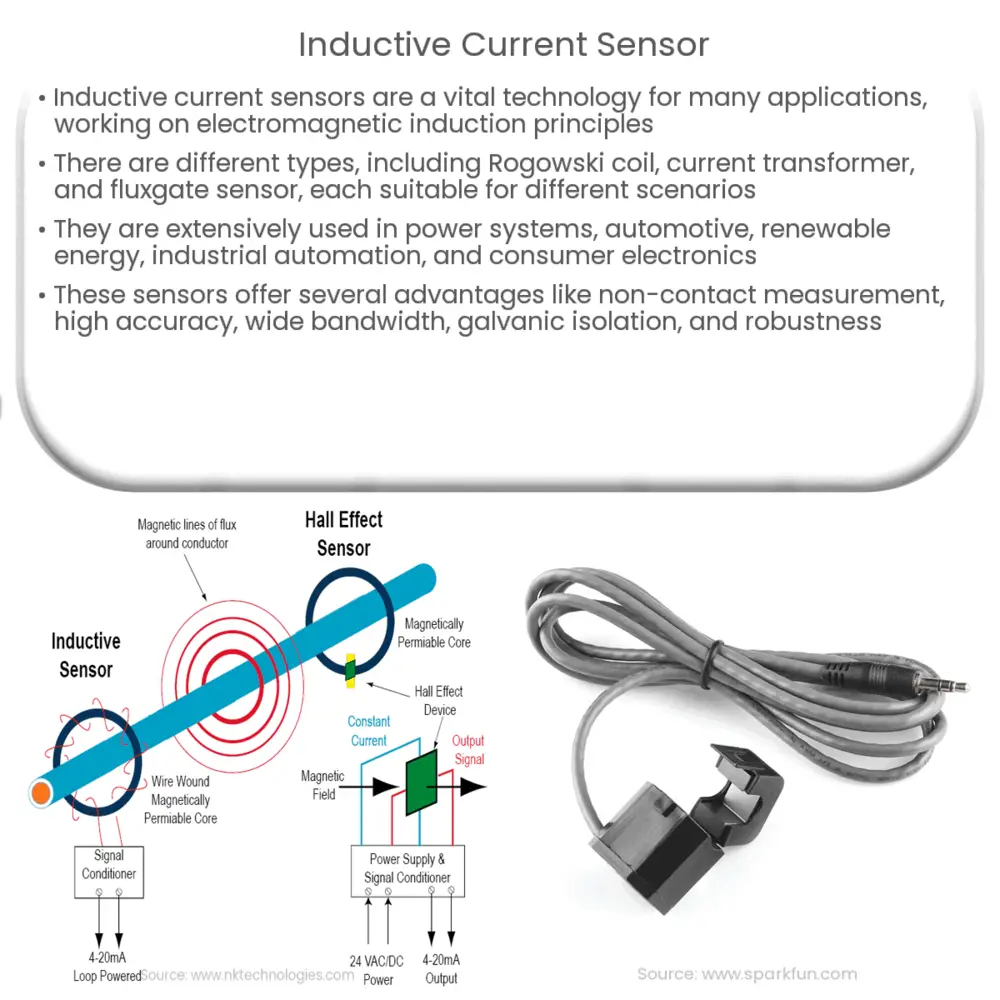Inductive current sensors are non-contact devices that accurately measure electric currents in various applications, ensuring efficient operation and protection of electrical systems.

Inductive Current Sensors: Principles, Applications, and Benefits
Introduction
Inductive current sensors are crucial components in many industrial, automotive, and energy applications. They provide a non-contact and highly accurate method of measuring electric currents, making them an essential technology for monitoring, controlling, and protecting electrical systems. This article will discuss the principles of operation, common applications, and benefits of inductive current sensors.
Principles of Operation
Inductive current sensors are based on the principle of electromagnetic induction, which is the process by which a magnetic field generates an electric current in a conductor. In the case of inductive current sensors, this conductor is typically a coil of wire that surrounds the current-carrying conductor being measured. As the current flows through the conductor, it creates a magnetic field that varies in strength and direction. This magnetic field, in turn, induces a voltage in the surrounding coil, which is proportional to the rate of change of the magnetic field.
By measuring the induced voltage in the coil, it is possible to determine the magnitude and direction of the current flowing through the conductor. This relationship between the current in the conductor and the induced voltage in the coil is described by Faraday’s law of electromagnetic induction:
V = -N * (dΦ/dt)
where V is the induced voltage, N is the number of turns in the coil, dΦ is the change in magnetic flux, and dt is the change in time. The negative sign indicates that the induced voltage is in the opposite direction of the change in magnetic flux.
Types of Inductive Current Sensors
There are several types of inductive current sensors available, each with their unique characteristics and applications. Some of the most common types include:
- Rogowski coil: A flexible, air-core coil that is wound around the conductor being measured. It provides a linear output voltage proportional to the rate of change of the current and is well-suited for high-frequency and high-current applications.
- Current transformer (CT): A toroidal (ring-shaped) core made of ferromagnetic material with a secondary coil wound around it. The primary conductor passes through the center of the core, and the secondary coil produces a scaled-down version of the primary current. CTs are widely used in power systems for current measurement and protection.
- Fluxgate sensor: A device that uses a ferromagnetic core and two oppositely wound secondary coils to measure the magnetic field generated by the current-carrying conductor. The sensor output is a voltage proportional to the current, making it suitable for direct current (DC) and low-frequency alternating current (AC) applications.
Applications of Inductive Current Sensors
Inductive current sensors find use in a wide range of applications across various industries, some of which include:
- Power systems: Current transformers are widely used in power systems for current monitoring, metering, and protection. They help ensure the stability and safety of the electrical grid by providing accurate current measurements for fault detection and load management.
- Automotive: Inductive current sensors are used in electric and hybrid vehicles to monitor the battery and charging system, as well as for controlling electric motors in various systems such as power steering and HVAC.
- Renewable energy: In solar and wind power systems, inductive current sensors play a crucial role in monitoring the performance of inverters, converters, and transformers, ensuring optimal energy conversion and grid integration.
- Industrial automation: Inductive current sensors are used to monitor motor currents in various industrial processes, providing valuable information for controlling and optimizing the performance of motors, drives, and automation systems.
- Consumer electronics: Fluxgate sensors and other small inductive sensors are used in consumer electronics for current sensing in battery management systems, power supplies, and charging circuits.
Benefits of Inductive Current Sensors
Inductive current sensors offer several advantages over other current measurement techniques, including:
- Non-contact measurement: Inductive sensors measure current without direct electrical contact, reducing the risk of electrical faults and simplifying installation and maintenance.
- High accuracy: Inductive current sensors provide accurate current measurements over a wide range of frequencies and current levels, making them suitable for various applications.
- Wide bandwidth: Inductive sensors, such as Rogowski coils, can measure high-frequency currents, enabling their use in applications like high-speed switching and power electronics.
- Galvanic isolation: Current transformers provide galvanic isolation between the primary and secondary circuits, enhancing the safety and reliability of the electrical system.
- Robustness: Inductive current sensors are generally more robust and less susceptible to environmental factors, such as temperature and humidity, than other current sensing technologies.
Conclusion
Inductive current sensors are a critical technology in numerous applications across various industries. They offer a non-contact, highly accurate, and reliable method for measuring electric currents, ensuring the efficient operation and protection of electrical systems. As the demand for electric and hybrid vehicles, renewable energy systems, and industrial automation continues to grow, inductive current sensors will undoubtedly play an increasingly important role in these technologies.

